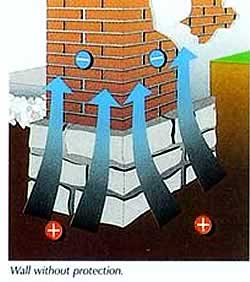NEWS ARTICLE ARCHIVESPrevent rising damp with Lectros
As moisture rises from the earth by capillary action through the walls pore structure it creates an electrical potential, (Zeta Potential), between the wall and the moisture. This "potential" causes more and more water molecules carrying damaging ground salts to travel from the positive, (the earth), towards the negative, (up the walls). Rising damp can be caused by the absence of an effective damp-course or by "bridging" of the damp-course. During bricklaying excess mortar often falls down behind the brickwork, into cavities where it sticks to brick ties, and lands in the gaps between the floor joists, bearers and brickwork. These mortar droppings can create a moisture bridge - a direct path for moisture to creep from damp masonry to your floor bearers and joists, perimeter timber framing, plaster and timber trims. As the moisture content varies within the masonry it induces a wetting/drying cycle causing the salts to expand and contract accordingly, hence the breakdown and deterioration of the plaster, brick/stonework and mortar. As excess moisture evaporates a surface salt residue is left behind. |
 |
 |
 Rising damp is found naturally in most masonry structures as the moisture in soil and masonry tries to achieve equilibrium. This equilibrium occurs in nature and is evident in many forms such as, temperature - where heat spreads from hot to cold, electricity - where a positive charge flows to the negative and in water - where dampness invades a dry area. That's why the Building Code of Australia requires that a damp-course is installed to prevent "undue dampness or deterioration of building elements" and it's also why builders install a damp-course below the timber floor bearers.
Rising damp is found naturally in most masonry structures as the moisture in soil and masonry tries to achieve equilibrium. This equilibrium occurs in nature and is evident in many forms such as, temperature - where heat spreads from hot to cold, electricity - where a positive charge flows to the negative and in water - where dampness invades a dry area. That's why the Building Code of Australia requires that a damp-course is installed to prevent "undue dampness or deterioration of building elements" and it's also why builders install a damp-course below the timber floor bearers.